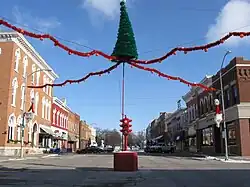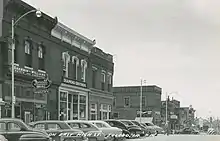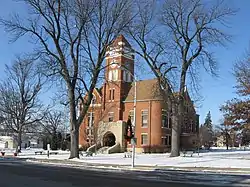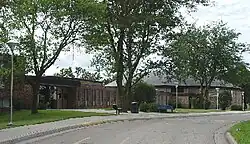Toledo, Iowa
Toledo is a city in, and the county seat of, Tama County, Iowa, United States.[2] The population was 2,369 at the time of the 2020 census.[3]
Toledo, Iowa | |
|---|---|
 Toledo, Iowa | |
| Nickname: Twin Cities | |
| Motto(s): Remembering Our Past, Looking Toward Our Future | |
 Location of Toledo, Iowa | |
| Coordinates: 41°59′36″N 92°34′45″W | |
| Country | |
| State | |
| County | Tama |
| Government | |
| • Mayor | Brian Sokol |
| Area | |
| • Total | 2.29 sq mi (5.94 km2) |
| • Land | 2.29 sq mi (5.94 km2) |
| • Water | 0.00 sq mi (0.00 km2) |
| Elevation | 906 ft (276 m) |
| Population (2020) | |
| • Total | 2,369 |
| • Density | 1,032.24/sq mi (398.59/km2) |
| Time zone | UTC-6 (Central (CST)) |
| • Summer (DST) | UTC-5 (CDT) |
| ZIP code | 52342 |
| Area code | 641 |
| FIPS code | 19-78510 |
| GNIS feature ID | 0462271 |
| Website | www |
History

Toledo was founded in 1853 as the county seat of Tama County.[4] It was named after Toledo, Ohio.[5] Toledo was incorporated as a city in 1866.[4]
Geography
Toledo is located at 41°59′36″N 92°34′45″W (41.993281, -92.579067).[6]
According to the United States Census Bureau, the city has a total area of 2.30 square miles (5.96 km2), all land.[7]
Climate
According to the Köppen Climate Classification system, Toledo has a hot-summer humid continental climate, abbreviated "Dfa" on climate maps.
| Climate data for Toledo, Iowa, 1991–2020 normals, extremes 1894–present | |||||||||||||
|---|---|---|---|---|---|---|---|---|---|---|---|---|---|
| Month | Jan | Feb | Mar | Apr | May | Jun | Jul | Aug | Sep | Oct | Nov | Dec | Year |
| Record high °F (°C) | 63 (17) |
72 (22) |
88 (31) |
95 (35) |
106 (41) |
105 (41) |
109 (43) |
108 (42) |
103 (39) |
95 (35) |
82 (28) |
73 (23) |
109 (43) |
| Mean maximum °F (°C) | 48.5 (9.2) |
54.4 (12.4) |
70.4 (21.3) |
80.8 (27.1) |
87.3 (30.7) |
91.8 (33.2) |
93.0 (33.9) |
91.4 (33.0) |
89.5 (31.9) |
83.0 (28.3) |
67.8 (19.9) |
53.5 (11.9) |
94.6 (34.8) |
| Average high °F (°C) | 26.8 (−2.9) |
31.5 (−0.3) |
45.1 (7.3) |
59.2 (15.1) |
70.3 (21.3) |
79.7 (26.5) |
83.0 (28.3) |
81.1 (27.3) |
75.1 (23.9) |
62.0 (16.7) |
46.0 (7.8) |
32.6 (0.3) |
57.7 (14.3) |
| Daily mean °F (°C) | 18.1 (−7.7) |
22.4 (−5.3) |
34.9 (1.6) |
47.5 (8.6) |
59.2 (15.1) |
69.2 (20.7) |
72.5 (22.5) |
70.2 (21.2) |
62.9 (17.2) |
50.4 (10.2) |
36.3 (2.4) |
24.2 (−4.3) |
47.3 (8.5) |
| Average low °F (°C) | 9.4 (−12.6) |
13.2 (−10.4) |
24.6 (−4.1) |
35.7 (2.1) |
48.0 (8.9) |
58.7 (14.8) |
61.9 (16.6) |
59.3 (15.2) |
50.8 (10.4) |
38.9 (3.8) |
26.6 (−3.0) |
15.8 (−9.0) |
36.9 (2.7) |
| Mean minimum °F (°C) | −13.2 (−25.1) |
−8.2 (−22.3) |
3.3 (−15.9) |
21.2 (−6.0) |
33.7 (0.9) |
46.2 (7.9) |
51.7 (10.9) |
49.4 (9.7) |
36.3 (2.4) |
23.4 (−4.8) |
9.9 (−12.3) |
−5.2 (−20.7) |
−17.1 (−27.3) |
| Record low °F (°C) | −31 (−35) |
−34 (−37) |
−31 (−35) |
5 (−15) |
22 (−6) |
34 (1) |
40 (4) |
34 (1) |
17 (−8) |
−8 (−22) |
−10 (−23) |
−28 (−33) |
−34 (−37) |
| Average precipitation inches (mm) | 0.98 (25) |
1.01 (26) |
1.79 (45) |
3.51 (89) |
4.80 (122) |
5.60 (142) |
4.05 (103) |
3.99 (101) |
3.48 (88) |
2.82 (72) |
2.02 (51) |
1.20 (30) |
35.25 (894) |
| Average snowfall inches (cm) | 8.6 (22) |
7.9 (20) |
4.2 (11) |
1.1 (2.8) |
0.2 (0.51) |
0.0 (0.0) |
0.0 (0.0) |
0.0 (0.0) |
0.0 (0.0) |
0.4 (1.0) |
1.8 (4.6) |
8.6 (22) |
32.8 (83.91) |
| Average precipitation days (≥ 0.01 in) | 6.9 | 6.9 | 7.8 | 10.2 | 11.7 | 11.5 | 8.8 | 9.5 | 7.8 | 8.2 | 6.6 | 6.6 | 102.5 |
| Average snowy days (≥ 0.1 in) | 4.8 | 4.6 | 2.4 | 0.7 | 0.1 | 0.0 | 0.0 | 0.0 | 0.0 | 0.3 | 1.2 | 4.2 | 18.3 |
| Source 1: NOAA[8] | |||||||||||||
| Source 2: National Weather Service[9] | |||||||||||||
Demographics

| Year | Pop. | ±% |
|---|---|---|
| 1870 | 888 | — |
| 1880 | 1,026 | +15.5% |
| 1890 | 1,836 | +78.9% |
| 1900 | 1,941 | +5.7% |
| 1910 | 1,626 | −16.2% |
| 1920 | 1,604 | −1.4% |
| 1930 | 1,825 | +13.8% |
| 1940 | 2,073 | +13.6% |
| 1950 | 2,106 | +1.6% |
| 1960 | 2,417 | +14.8% |
| 1970 | 2,361 | −2.3% |
| 1980 | 2,455 | +4.0% |
| 1990 | 2,380 | −3.1% |
| 2000 | 2,539 | +6.7% |
| 2010 | 2,341 | −7.8% |
| 2020 | 2,369 | +1.2% |
| Source:"U.S. Census website". United States Census Bureau. Retrieved March 29, 2020. and Iowa Data Center Source: | ||
2010 census
As of the census[11] of 2010, there were 2,341 people, 901 households, and 598 families living in the city. The population density was 1,017.8 inhabitants per square mile (393.0/km2). There were 993 housing units at an average density of 431.7 per square mile (166.7/km2). The racial makeup of the city was 83.5% White, 1.1% African American, 5.8% Native American, 0.6% Asian, 4.3% from other races, and 4.8% from two or more races. Hispanic or Latino of any race were 11.4% of the population.
There were 901 households, of which 31.5% had children under the age of 18 living with them, 51.4% were married couples living together, 10.5% had a female householder with no husband present, 4.4% had a male householder with no wife present, and 33.6% were non-families. 28.3% of all households were made up of individuals, and 13.3% had someone living alone who was 65 years of age or older. The average household size was 2.43 and the average family size was 2.94.
The median age in the city was 40.3 years. 27.5% of residents were under the age of 18; 6.9% were between the ages of 18 and 24; 21.4% were from 25 to 44; 25.8% were from 45 to 64; and 18.3% were 65 years of age or older. The gender makeup of the city was 46.3% male and 53.7% female.
2000 census
As of the census[12] of 2000, there were 2,539 people, 982 households, and 632 families living in the city. The population density was 1,105.9 inhabitants per square mile (427.0/km2). There were 1,050 housing units at an average density of 457.4 per square mile (176.6/km2). The racial makeup of the city was 87.51% White, 0.51% African American, 5.83% Native American, 0.35% Asian, 0.04% Pacific Islander, 2.91% from other races, and 2.84% from two or more races. Hispanic or Latino of any race were 5.87% of the population.
There were 982 households, out of which 30.0% had children under the age of 18 living with them, 49.1% were married couples living together, 12.6% had a female householder with no husband present, and 35.6% were non-families. 30.8% of all households were made up of individuals, and 16.6% had someone living alone who was 65 years of age or older. The average household size was 2.36 and the average family size was 2.93.
Age spread: 27.4% under the age of 18, 8.7% from 18 to 24, 24.4% from 25 to 44, 20.1% from 45 to 64, and 19.4% who were 65 years of age or older. The median age was 38 years. For every 100 females, there were 84.8 males. For every 100 females age 18 and over, there were 81.9 males.
The median income for a household in the city was $33,750, and the median income for a family was $40,833. Males had a median income of $30,273 versus $22,349 for females. The per capita income for the city was $16,293. About 8.5% of families and 11.0% of the population were below the poverty line, including 17.9% of those under age 18 and 7.0% of those age 65 or over.
Government and infrastructure
The Iowa Department of Human Services operated the Iowa Juvenile Home in Toledo.
Notable people
- Leander Clark, Iowa politician
- King Cole, baseball pitcher, gave up Babe Ruth's first hit
- W. K. Davidson (1904-1974), Illinois businessman and state legislator
- Michael Emerson, actor
- Norma 'Duffy' Lyon (1929–2011) sculptor nicknamed the "Butter Cow Lady"[13]
- George R. Struble, Iowa judge and politician; speaker of the Iowa House of Representatives, 1881–1883
- John T. Struble, pioneering businessman
- Isaac S. Struble, U.S. Representative
- John L. Waller, Politician and Consul to Madagascar (1891)
Education

Toledo is within the South Tama County Community School District.[14] The district includes a class 3A high school that enrolls over 430 students, a middle school, and an elementary school that has over 700 students.[15]
Parks and Recreation
Toledo Heights sits on the west side of town. The park has two fields which are used for little-league baseball and softball. The park has a playground and a large picnic shelter. Surrounding the park is an 18-hole disc golf course. The South Tama Recreation Trail is accessible near Toledo Heights. The gravel trail covers just under 3 miles and continues into Tama.
Each summer, the annual Stoplight Festival takes place on the town square. The celebration surrounds the historic stoplight located at the intersection of High Street and Broadway.
Arts
The Wieting Theatre is located in downtown Toledo, one block east of the stoplight and the Tama County Courthouse square, at 101 South Church Street. Since 1960 the theatre has been maintained and operated by the Wieting Theatre Guild, a nonprofit organization of members and volunteers dedicated to keeping the doors of this grand old theatre open for many years to come. Movies play on most Friday, Saturday and Sunday evenings throughout the year. Actors, musicians, singers and dancers of all ages take the stage on numerous other occasions.[16]
Healthcare
Toledo area residents have access to healthcare services at MercyCare or Unity Point Toledo. When hospitalization is required the closest and most convenient hospital for residents is Grinnell Regional Medical Center or Unity Point Hospital in Marshalltown.
References
- "2020 U.S. Gazetteer Files". United States Census Bureau. Retrieved March 16, 2022.
- "Find a County". National Association of Counties. Retrieved June 7, 2011.
- "2020 Census State Redistricting Data". census.gov. United states Census Bureau. Retrieved August 12, 2021.
- Chapman, Samuel D. (1879). History of Tama County, Iowa: Its Cities, Towns and Villages. Toledo Times Office. pp. 201–202.
- Chicago and North Western Railway Company (1908). A History of the Origin of the Place Names Connected with the Chicago & North Western and Chicago, St. Paul, Minneapolis & Omaha Railways. p. 131.
- "US Gazetteer files: 2010, 2000, and 1990". United States Census Bureau. February 12, 2011. Retrieved April 23, 2011.
- "US Gazetteer files 2010". United States Census Bureau. Archived from the original on January 25, 2012. Retrieved May 11, 2012.
- "U.S. Climate Normals Quick Access". National Oceanic and Atmospheric Administration. Retrieved August 4, 2022.
- "NOAA Online Weather Data". National Weather Service. Retrieved August 4, 2022.
- "Census of Population and Housing". Census.gov. Retrieved June 4, 2015.
- "U.S. Census website". United States Census Bureau. Retrieved May 11, 2012.
- "U.S. Census website". United States Census Bureau. Retrieved January 31, 2008.
- Potter, Andrew (June 28, 2011). "Toledo cherishes memories of 'The Butter Cow Lady'". Times-Republican. Archived from the original on September 27, 2011. Retrieved June 28, 2011.
- "South Tama County" (PDF). Iowa Department of Education. Retrieved March 28, 2020.
- "South Tama County Community School District". s-tama.k12.ia.us. 2011. Retrieved February 12, 2011.
- "The Wieting Theatre". wieting.tamatoledo.com.